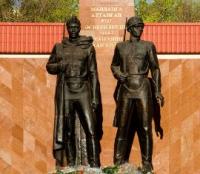Вы здесь
Monument of Akmola warriors in Astana.

New offers for excursions in Astana.
“...The evil of war and the good of peace are so well known to people that since we know people, the best wish has been the greeting“ Peace be to you.”
Tolstoy L.N.
Cost of tours in Astana.
The figures of Akmola warriors embodied in bronze are installed in the central part of the city on Victory Avenue. During the Great Patriotic War, Akmolinsk became the birthplace of 310, 387 and 29 (renamed 72 Guards) infantry divisions.
On May 9, 1995, in honor of the 50th anniversary of the Great Victory, a monument dedicated to the soldiers of 310, 387 and 72 Guards divisions who fell in battles with the Nazi invaders was inaugurated. The author of the monument is the sculptor V. Pirozhkov, the architect is V. Toskin.
The monument, made close to the forms of easel sculpture, generically embodied the images of young fighters, life-truthful, psychologically convincing, personifying volunteers who did not return from the fields of battle, evoking a sense of deep sorrow in people's memory.
The monument is simple and at the same time full of great meaning. Two soldiers with open and young faces go to the front. According to its ideological-figurative content, composition and plastic solution, it follows in line with those changes. which developed in the art of the 60 - 70s. XX century.
The images embodied in bronze remind our contemporaries of their sons, fathers, husbands, who went to war in those distant and severe 1941 - 1945. 310 rifle division was formed in July 1941 in the city of Akmolinsk from conscripts of Akmolinskaya. Karaganda, Kokchetav, North Kazakhstan and Kustanai regions.
The formation ended on July 30, 1941. On August 18-19, 1941, the division was sent to the army and became a part of the North-Western Front. At the time of formation, the division consisted of 40,060 Kazakhs, 30% from Russians, 25% from Ukrainians, 5% from representatives of other nationalities.
As part of the army from August 27, 1941 to June 8, 1944, from June 16, 1944 to November 15, 1944 and from January 28, 1945 to May 9, 1945. Starting from September 8, 1941, the division participated in Sinyavinsky operations undertaken to break the blockade of Leningrad from the east, advancing, in particular, in the direction of the villages of the 1st Estonian and Tortolovo.
The division suffered considerable losses, however, it advanced 10 - 15 kilometers. Offensive operations were also conducted during October 1941. Until 1944, it conducted defensive and offensive battles at the turn of the Volkhov River in the area of the Kirishi bridgehead.
On January 20, 1944, the division was given the honorary name Novgorodskay. He was awarded the Order of the Red Banner and the Order of Lenin. The 387th rifle division was formed at the end of August 1941 in Akmolinsk from conscripts of the Akmola and Karaganda regions.
On November 6, 1941, she left for the front, was included in the 61st Army, and was deployed in the areas of Ryazhsk, Ranenburg, and Michurinsk. The first battle took place on 12.27.1941 near the village of Troitskoye, Ulyanovsk Region, Oryol Region during offensive operations in the Volkhov and Oryol directions.
In December 1942, the division was transferred to Stalingrad, where, after making a heavy forced march, passing from unloading places to areas of concentration of 200-280 kilometers, reached the line of the Myshkova River by December 19, 1942, where it took part in repelling the blow of German troops carried out with the goal of the deblockade of the encircled group, and on December 24 went on the offensive.
In September 1943, it was withdrawn to the reserve, then included in the 51st army. Since 10.04.1944, it has participated in the Crimean offensive operation, storming Perekop. An important role in the army offensive was played by the landing of the reinforced rifle battalion of the 1271th regiment of the division, landed at 5 hours 20 minutes 04.10.1944 in the area of 3 kilometers southwest of Kuraevka. This landing was tasked with speeding up Perekopsky flood and capturing Kart-Kazak No. 1 no later than 6 hours on April 10.
The landing operations were very energetic; after landing, he quickly captured Kart-Kazak No. 1 and forced the enemy to clear Kuraevka, which contributed greatly to the successful offensive. In 1944, the division was given the honorary name "Perekop".
The 72nd Guards Rifle Division is a military unit of the USSR in the Great Patriotic War. Formed 03.01.1943 by transforming the 29th Infantry Division. In the army from 03.01.1943 to 05.11.1945. On March 19, 1943, the division took the line along the eastern coast of the Seversky Donets and immediately entered the battle.
From 07.05.1943 took part in the Battle of Kursk (southern face of the Kursk Bulge), was forced out of occupied lines, with the beginning of the offensive, occupied them again, forced the Seversky Donets, took part in the liberation of the cities of Merefa and Krasnograd, forced the Dnieper, seizing the bridgehead, liberated Left-bank Ukraine, Kirovohrad, forced the Southern Bug.
At the end of August 1944 she crossed the border, in January 1945 she crossed the Don, took control of the city of Kamendin, during the fighting of February 1945 she was knocked out of the bridgehead, restored her position and, having forced Morava, entered the territory of Austria, ended the war not far from Prague.
The division was nicknamed by the soldiers “Irreplaceable, Waterproof, and Unapproachable,” due to the fact that the division was never assigned to the front line either for reserve or for rest or for reorganization for any length of time.
09.19.1943 - the honorary name “Krasnogradskaya” was awarded. 01.08.1944 - was awarded the Order of the Red Banner.







